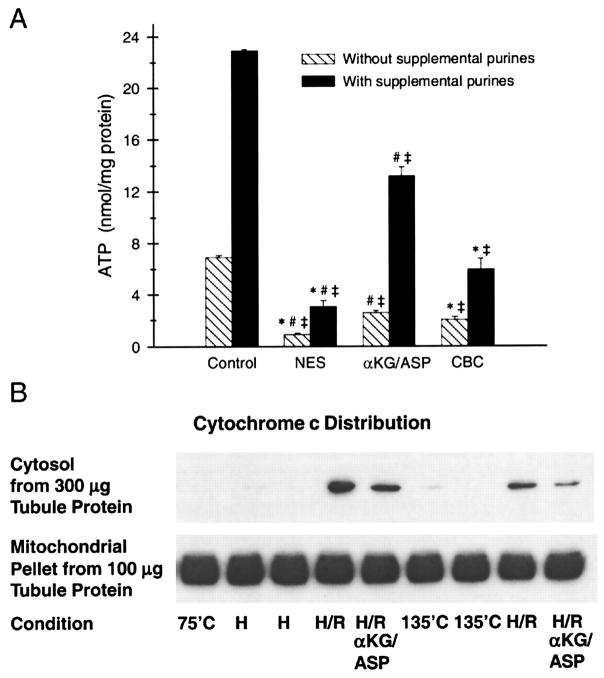Fig. 2.
Energetic deficit after hypoxia-reoxygenation and its modification by mitochondrial permeability transition (MPT) inhibitors and α-KG/ASP. A: ATP levels of reoxygenated tubules. Tubules were subjected to 60 min hypoxia (2 mM glycine, pH 6.9) and 60 min reoxygenation (2 mM glycine, pH 7.4) with either no extra substrate (NES), or 4 mM α-ketoglutarate + 4 mM aspartate (α-KG/ASP) during reoxygenation alone, or cyclosporine A (5 μM) plus butacaine (30 μM) plus L-carnitine (2 mM) (CBC) during both hypoxia and reoxygenation. Reoxygenation was studied both without and with supplemental exogenous purine (250 μM ATP) to promote recovery of cell ATP. Control values shown are for parallel flasks from the same preparations incubated under oxygenated conditions for the same total duration as the experimental groups. The purine-supplemented control group had 250 μm ATP in its medium for the last 60 min of incubation. Cell ATP levels are means ± SE for N = 4–6, *significantly different from corresponding α-KG/ASP group, #significantly different from corresponding CBC group, and ‡significantly different from corresponding control group. B: immunoblot of cytochrome c in membrane pellets containing mitochondria and the corresponding cytosol supernatants. Tubules were incubated under oxygenated control conditions for either 75 min (75′C) or 135 min (135′C), for 60 min hypoxia (H), or for 60 min hypoxia followed by 60 min reoxygenation (H/R) with or without 4 mM α-KG/ASP. Repeated conditions are from separate flasks. To provide a visible signal, the amount of protein for the cytosolic fractions was increased 3 fold relative to its actual proportion between the 2 types of samples. The percentages of total cytochrome c in the supernatants were 0.50 ± 0.12 in the H/R group without supplemental substrates and 0.21 ± 0.07 in the α-KG/ASP-treated group (N = 3).

